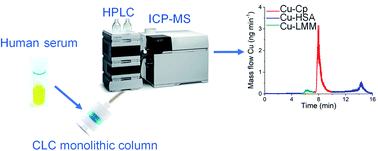Speciation of copper in human serum using conjoint liquid chromatography on short-bed monolithic disks with UV and post column ID-ICP-MS detection†
Abstract
Ceruloplasmin (Cp) is the major copper-carrying (Cu) protein in human plasma. Due to copper's important physiological functions and its role in various diseases, there is a need to quantify the concentration bound to Cp and the exchangeable form of Cu. In the present work, conjoint liquid chromatography (CLC) on short-bed convective interaction media (CIM) monolithic disks was used to separate the Cu bound to low molecular mass (LMM) species, and the Cu bound to Cp and albumin (HSA) in human serum. Two immunoaffinity CIMmic albumin depletion (α-HSA) disks and one CIMmic weak anion-exchange diethylaminoethyl (DEAE) disk were assembled in a single housing, forming a CLC monolithic column. By applying isocratic elution with a 50 mmol L−1 MOPS buffer (pH 7.4) in the first 3 min, followed by gradient elution with 1 mol L−1 NH4Cl (pH 7.4) in the next 9 min, HSA was retained by the α-HSA disk, allowing subsequent separation of the LMM-Cu from the Cu bound to the Cp on the DEAE disk. Further elution with 0.5 mol L−1 acetic acid in the next 4 min rinsed the HSA from the α-HSA disk. The separated Cu species were quantified by post-column isotope dilution inductively coupled plasma mass spectrometry (ID-ICP-MS), while the elution profile of the proteins was followed by UV detection at 278 nm. Quantitative column recoveries were obtained. Good repeatability of the measurement was achieved for Cu-Cp (±1%), while for Cu-HSA and Cu-LMM species the repeatability of the measurements was slightly worse, due to the much lower Cu concentrations (±6% and ±9%, respectively). The developed method required only 20 μL of a 15-times diluted sample. Low limits of detection for the Cu-Cp, Cu-HSA and Cu-LMM species (6.1, 5.3 and 3.3 ng mL−1 Cu, respectively) were obtained. The technique was successfully applied in the determination of Cu-Cp, Cu-HSA and a fraction that most probably corresponds to the Cu-LMM species in the human serum of healthy individuals, kidney transplant patients and cancer patients.

- This article is part of the themed collection: JAAS HOT Articles 2022


 Please wait while we load your content...
Please wait while we load your content...